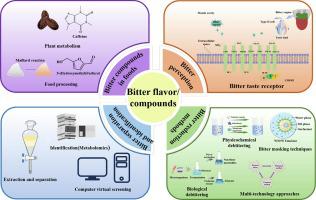当前位置:
X-MOL 学术
›
Food Res. Int.
›
论文详情
Our official English website, www.x-mol.net, welcomes your feedback! (Note: you will need to create a separate account there.)
Bitter flavors and bitter compounds in foods: identification, perception, and reduction techniques
Food Research International ( IF 8.1 ) Pub Date : 2024-03-13 , DOI: 10.1016/j.foodres.2024.114234 Xinyu Chu , Wangsheng Zhu , Xue Li , Erzheng Su , Jiahong Wang
Food Research International ( IF 8.1 ) Pub Date : 2024-03-13 , DOI: 10.1016/j.foodres.2024.114234 Xinyu Chu , Wangsheng Zhu , Xue Li , Erzheng Su , Jiahong Wang

|
Bitterness is one of the five basic tastes generally considered undesirable. The widespread presence of bitter compounds can negatively affect the palatability of foods. The classification and sensory evaluation of bitter compounds have been the focus in recent research. However, the rigorous identification of bitter tastes and further studies to effectively mask or remove them have not been thoroughly evaluated. The present paper focuses on identification of bitter compounds in foods, structural-based activation of bitter receptors, and strategies to reduce bitter compounds in foods. It also discusses the roles of metabolomics and virtual screening analysis in bitter taste. The identification of bitter compounds has seen greater success through metabolomics with multivariate statistical analysis compared to conventional chromatography, HPLC, LC-MS, and NMR techniques. However, to avoid false positives, sensory recognition should be combined. Bitter perception involves the structural activation of bitter taste receptors (TAS2Rs). Only 25 human TAS2Rs have been identified as responsible for recognizing numerous bitter compounds, showcasing their high structural diversity to bitter agonists. Thus, reducing bitterness can be achieved through several methods. Traditionally, the removal or degradation of bitter substances has been used for debittering, while the masking of bitterness presents a new effective approach to improving food flavor. Future research in food bitterness should focus on identifying unknown bitter compounds in food, elucidating the mechanisms of activation of different receptors, and developing debittering techniques based on the entire food matrix.
中文翻译:

食品中的苦味和苦味化合物:识别、感知和减少技术
苦味是通常被认为不受欢迎的五种基本味道之一。苦味化合物的广泛存在会对食物的适口性产生负面影响。苦味化合物的分类和感官评价一直是近年来研究的热点。然而,苦味的严格鉴定以及有效掩盖或消除苦味的进一步研究尚未得到彻底评估。本文重点关注食品中苦味化合物的鉴定、苦味受体的基于结构的激活以及减少食品中苦味化合物的策略。它还讨论了代谢组学和虚拟筛选分析在苦味中的作用。与传统色谱、HPLC、LC-MS 和 NMR 技术相比,通过多变量统计分析的代谢组学鉴定苦味化合物取得了更大的成功。然而,为避免误报,应结合感官识别。苦味感知涉及苦味受体(TAS2R)的结构激活。只有 25 个人类 TAS2R 被确定负责识别多种苦味化合物,展示了它们对苦味激动剂的高度结构多样性。因此,可以通过多种方法来降低苦味。传统上,苦味物质的去除或降解已被用于脱苦,而苦味的掩蔽则为改善食品风味提供了一种新的有效方法。未来对食品苦味的研究应侧重于识别食品中未知的苦味化合物,阐明不同受体的激活机制,并开发基于整个食品基质的脱苦技术。
更新日期:2024-03-13
中文翻译:

食品中的苦味和苦味化合物:识别、感知和减少技术
苦味是通常被认为不受欢迎的五种基本味道之一。苦味化合物的广泛存在会对食物的适口性产生负面影响。苦味化合物的分类和感官评价一直是近年来研究的热点。然而,苦味的严格鉴定以及有效掩盖或消除苦味的进一步研究尚未得到彻底评估。本文重点关注食品中苦味化合物的鉴定、苦味受体的基于结构的激活以及减少食品中苦味化合物的策略。它还讨论了代谢组学和虚拟筛选分析在苦味中的作用。与传统色谱、HPLC、LC-MS 和 NMR 技术相比,通过多变量统计分析的代谢组学鉴定苦味化合物取得了更大的成功。然而,为避免误报,应结合感官识别。苦味感知涉及苦味受体(TAS2R)的结构激活。只有 25 个人类 TAS2R 被确定负责识别多种苦味化合物,展示了它们对苦味激动剂的高度结构多样性。因此,可以通过多种方法来降低苦味。传统上,苦味物质的去除或降解已被用于脱苦,而苦味的掩蔽则为改善食品风味提供了一种新的有效方法。未来对食品苦味的研究应侧重于识别食品中未知的苦味化合物,阐明不同受体的激活机制,并开发基于整个食品基质的脱苦技术。



























 京公网安备 11010802027423号
京公网安备 11010802027423号